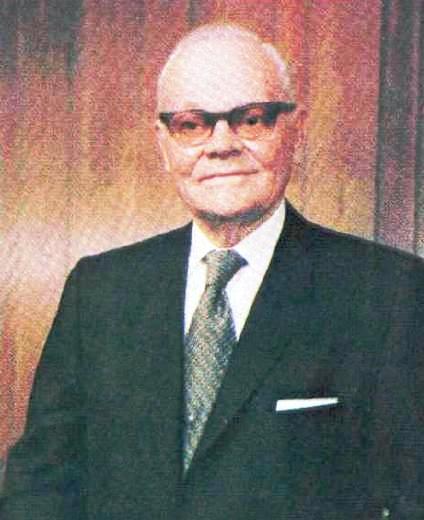Marion G. Romney
(1897-1988)


By Susan Easton Black
Marion spent his childhood and youth in the Mormon colonies in northern Mexico. He was baptized at age eight and received his patriarchal blessing from his grandfather Lemuel Redd at age twelve. In that blessing, Marion was promised that “if he would be faithful, he would become mighty in expounding the scriptures.”1
When Marion was fourteen years old, a rebellion in Mexico forced him and his family to flee from the Mormon Colonies to the United States. They settled temporarily in Texas before moving on to California and then Idaho. While living in Rexburg, Idaho, Marion attended Ricks Academy, where he participated in debate, drama, and athletics. It was at the Academy that he became acquainted with Ida Jensen—a teacher and his future bride.
Their courtship was put on hold when Marion accepted a mission call to serve in Australia. On his mission, Marion was known among the missionaries as a gospel scholar. Because of his knowledge of the scriptures, he was very successful in answering doctrinal questions and in bringing many into baptismal waters. He wrote, “I honestly feel that [the Lord] has blessed me far beyond my merits.”2
Returning to the United States, Marion enrolled at the Brigham Young University in Provo, Utah. There was more than one reason why he enrolled at BYU: Ida Jensen was attending the university and completing her graduate work in teaching. Marion and Ida renewed their courtship and were married on September 12, 1924, in the Salt Lake Temple. Marion said of Ida, “She took over where Mother left off and has made me what I am.”3
The Romneys resided in Salt Lake City. Marion pursued his education at the University of Utah. He completed his bachelor’s degree in political science and history in the fall of 1926 and enrolled in the University of Utah Law School. After matriculating through law school, he passed the bar exam in 1929 and opened a legal practice in Salt Lake City. Not wanting to lose the spiritual ground he had gained on his mission, Marion came to his law office a half hour earlier than his associates each morning to read and ponder the scriptures.
By the 1930s Marion had taken an interest in Utah politics. In 1934 he was elected to the Utah House of Representatives. Although he anticipated completing his term in the legislature, he resigned in April 1935 when called to be bishop of the Salt Lake 33rd Ward. Three years later, on May 15, 1938, Marion was sustained as president of the Bonneville Stake.
After only serving three years as a stake president, he was startled to hear his name read aloud at the April 1941 general conference. It was proposed and unanimously accepted that Marion G. Romney serve as one of five Assistants to the Quorum of the Twelve Apostles. One of his legal associates asked him, “Are you going to accept?” “Yes,” Marion replied. When asked about the salary he would receive for being an Assistant to the Twelve, he responded, “I don’t know.” His law associate exclaimed, “Marion, you are a fool.”4
As an Assistant to the Twelve, Marion was given the responsibility to help the managing director of the Church Welfare Department. As he fulfilled that responsibility, Marion “could call every stake president in the Church by name, and was acquainted with every one of its welfare projects.”5 Providing for the poor from Church welfare brought him great joy.
In October 1951 Marion was sustained as a member of the Quorum of the Twelve Apostles. In a meeting of the quorum about eighteen months after his call, Marion said, “I hope I can be true to the gospel and to you Brethren. I have been one that could see weaknesses in other men, but they are getting a little dimmer.” Of his calling, he said,
I am grateful that ever since I became a member of the General Authorities, I have never closed a day with less to do than I had at the beginning of the day. I don’t worry about the policies of the Church over which I have no jurisdiction. I am too busy. I am however, concerned about three things: keeping myself worthy, first; my strength, second; and third, my ability to fulfill the assignments which come to me.
I don’t remember in my life of ever being in doubt about the truthfulness of the gospel. I cannot remember, at least, a time when I didn’t know that the Lord lives. My testimony has changed in that today it is much easier to get an answer from the Lord. His presence is nearer. I know him much better now than I did fifty years ago.6
On July 7, 1972, Marion was sustained as the second counselor to Harold B. Lee in the First Presidency of the Church. “There is no man among my associates,” said President Lee, “who more closely emulates the life of the Savior than does my beloved brother, friend, and confidant, Marion G. Romney.”7 On December 30, 1973, Marion was named the second counselor to President Spencer W. Kimball and on December 2, 1982, the first counselor to President Kimball.
Near the end of his life, Marion suffered from partial blindness and Parkinson’s disease. In spite of deteriorating health, in 1985 Marion was sustained as President of the Quorum of the Twelve Apostles. Three years later, he died on May 20, 1988, at age ninety.
1. F. Burton Howard, Marion G Romney, His Life and Faith (Salt Lake City: Bookcraft, 1988), 34.
2. George Samuel Romney quote, in Howard, Marion G Romney, 80.
3. Howard, Marion G Romney, 145.
4. Howard, Marion G Romney, 115–116.
5. Howard, Marion G Romney, 123.
6. Howard, Marion G Romney, 184, 230.
7. Harold B. Lee quote, in Howard, Marion G Romney, 168–170.
